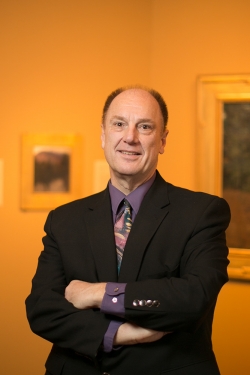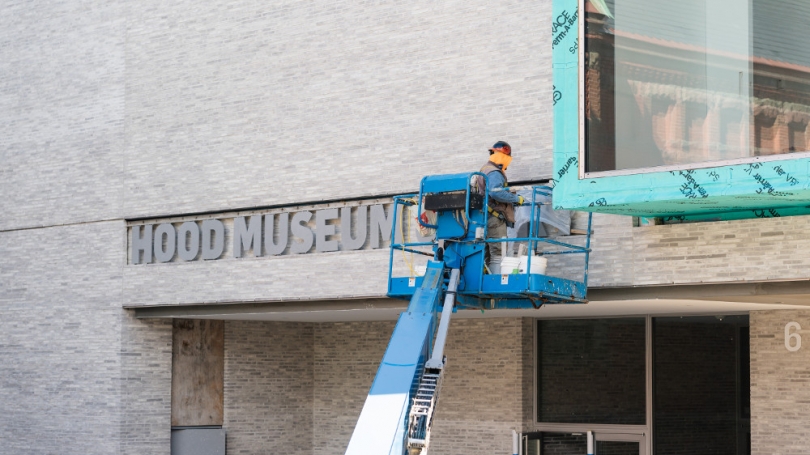The Hood director talks about what to expect when the renovated museum opens in January.
The newly renovated and expanded Hood Museum of Art opens Jan. 26, showcasing a collection that Virginia Rice Kelsey 1961s Director John Stomberg says represents art “around the world and through time.”
2015-1008530426.jpg

The Hood staff have been working for months to plan galleries, hang art, and celebrate the museum’s return with students, faculty, and the community.
Dartmouth News recently took a tour of the new building and we can say emphatically that it will be worth the wait. We spoke with Stomberg about what visitors can expect when the museum opens.
What’s been the biggest challenge of preparing the Hood to open?
Overall, our plans for reoccupying the galleries have gone very smoothly. The curatorial team has done an amazing job of thinking about what this new museum could look like, so we’re ahead of schedule and doing well installing the galleries that we have access to. The biggest challenge has been deciding what not to hang. Despite doubling our gallery space, we are still faced with difficult decisions. Including works new to the collection and that represent our goal of reflecting the College’s ideal of inclusive excellence has made for some difficult decisions.
What will surprise visitors about the new Hood?
How wonderful the flow of your visit will be. You’ll be able to amble through galleries, effortlessly moving from ancient Greece to contemporary Africa. The architects have created a unified experience, and some of the ways they’ve done that are very subtle. We’ve put the same oak floor in the whole museum. The lights in every gallery have been replaced—which makes it easier to control how we light the artworks, but also, the ceiling has parallel lines that aren’t really noticeable but that help shape your experience as you move through one space to another, so it feels like a continuous experience, rather than a bunch of singular galleries.
In the galleries, there are a couple of wonderful vantage points out windows that reconnect you with the outside world. They come up at surprising moments. You’ll discover a beautiful view of the sculpture park, for example. And as you move upstairs, there’s another view into the new atrium. The biggest is when you get to the vitrine gallery and look out the 14-foot window onto the Green. These are surprises that bring the outdoors in and make us a part of the campus.
The old museum felt more sequestered from the world.
It did. We are working hard to be part of the world. The architecture speaks to that connectivity with the life of campus and the life of the community.
The traditional role of museum guard has also changed. Why?
We’ve moved away from guards to a visitor-service guide model. We want people to know that our guides aren’t there to scold, but rather help them have a good visit. The idea of guides is that they provide information on the museum and what’s on view as well as safety and security.
How will students be engaged in the new Hood?
I think that the feeling of the Hood will be much more student-directed. In addition to our internship program, we have a new club for undergraduate enthusiasts. The focus is helping us come up with ideas for engaging other students. They also get to have special events here—they recently had a behind-the-scenes tour. We’re hoping that by having 40 active students working with us, things will happen that we can’t predict. We want to be responsive to that.
How are you preparing to make the most of the new object-study center?
We’ve been working with the faculty who will start teaching in that center right away, and we’re almost booked for the winter term. We now have much more capacity and the ability to share a wider range of objects. There’s almost nothing in our collection that we can’t bring into the teaching galleries through our 12-foot doors. That’s a big change. The spaces are really inviting, and we can use technology to a degree we couldn’t before.
Faculty are jazzed about bringing their classes, and they’re finding ways to work with our collection even more. For the first time, we may be able to have a course taught exclusively in one of our study galleries. The entire thing, soup to nuts, could be held here. We think we’ll have the bandwidth to offer this opportunity to one professor per term, which is just astounding.
What’s planned for opening day?
On Friday, Jan. 25, there will be a campus community dedication in the afternoon where President Hanlon will officially unveil the building. There will be a lecture from the architects and a dinner of appreciation for people involved with the museum. On Saturday, we open to the public at 11 a.m., and throughout the day there will be nonstop engagements with curators and educators—a big celebratory moment, with music and food and fun. On Sunday we open as a regular museum. Throughout the spring we’ll have other events, including a major conference in May where we’ll host a dozen artists who all have work in the museum.
What do people most want to know about the new museum?
The question I get all the time is, will it really be free? Yes. We’ve been very successful in our fundraising—the museum has been built 100 percent on philanthropy. So we will continue to be free. The other thing people will be happy to know is we are changing our hours. While we were at Hood Downtown, we discovered that closing Monday and Tuesday wasn’t a hardship, because we stayed open later some nights. So we’re staying open extra hours on Thursdays and Fridays.
The great thing about the Hood reopening is that it will become part of life on campus again, whether you’re walking by or coming to the galleries. With the Hood being free and easy to get to, you can just stop in for 10 minutes—you can meet somebody here, look at a painting, and then go out for coffee. There are so many ways to make the museum part of your life.
Hannah Silverstein can be reached at hannah.silverstein@dartmouth.edu.
